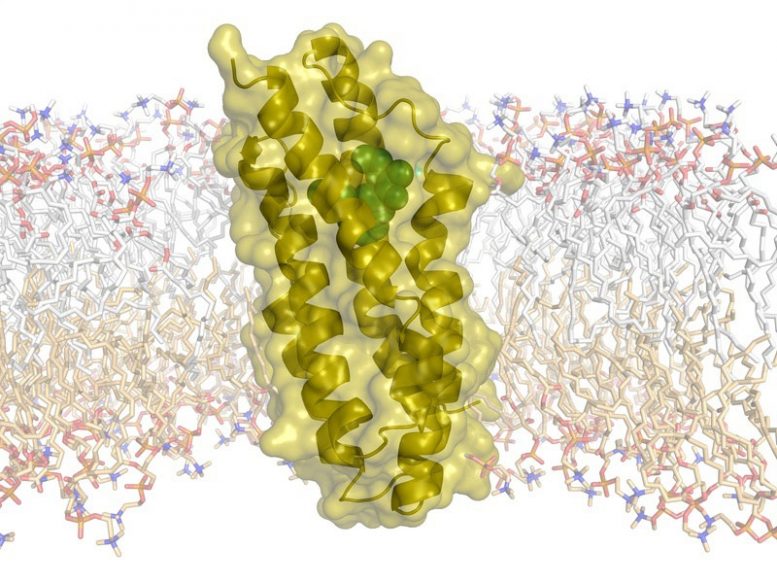
The cholesterol transporter TSPO in the outer mitochondrial membrane serves as a docking site for important diagnostic markers and for a number of drugs such as diazepam. Credit: Lukasz Jaremko, Mariusz Jaremko, Markus Zweckstetter / DZNE, MPI for Biophysical Chemistry and UMG
Scientists have revealed the 3D structure of the molecular transporter TSPO for the first time, opening the door to novel paths for the diagnosis and treatment of brain diseases.
The word “cholesterol” is directly linked in most people’s minds with high-fat foods, worrying blood test results, and cardiovascular diseases. However, despite its bad reputation, cholesterol is essential to our wellbeing: It stabilizes cell membranes and is a raw material for the production of different hormones in the cell’s power plants – the mitochondria. Now, for the first time, scientists in Göttingen have solved the high-resolution structure of the molecular transporter TSPO, which introduces cholesterol into mitochondria. This protein also serves as a docking site for diagnostic markers and different drugs, such as Valium. The detailed knowledge of its three-dimensional shape and function opens up new diagnostic and therapeutic perspectives.
Not only are mitochondria the most important energy supplier in living cells. They also produce steroid hormones such as testosterone and oestradiol, which control many processes in the body. The raw material for the production of steroid hormones is cholesterol, which must first be transported into mitochondria across two membranes. This difficult task is carried out by a molecular transport protein named TSPO in the outer mitochondrial membrane. Using nuclear magnetic resonance spectroscopy, two teams working with the Göttingen-based scientists Markus Zweckstetter and Stefan Becker have now shown the complex three-dimensional structure of the protein “at work” in atomic detail.
The researchers achieved this methodical breakthrough by applying an ingenious trick: In their experiments, they coupled the transporter to an important diagnostic marker called PK11195; it was this complex that first gave the scientists analyzable results. In fact, the TSPO structure delivers more than just clues about how cholesterol is transported into the mitochondria. “We now also have a much better understanding of how TSPO recognizes and binds to diagnostic markers and drugs”, explains Markus Zweckstetter, head of research groups at the German Center for Neurodegenerative Diseases (DZNE), at the Max Planck Institute for Biophysical Chemistry, and at the Center for Nanoscale Microscopy and Molecular Physiology of the Brain (CNMPB) at the University Medical Center of Göttingen (UMG).
TSPO has long been successfully used in diagnostics and treatment of a number of diseases. “When the brain is injured or inflamed, its cells produce more TSPO. This fact is used in the diagnosis of neurodegenerative diseases such as Parkinson’s and Alzheimer’s”, explains Stefan Becker, a protein chemist and Max Planck researcher who works next door to Zweckstetter.
Physicians also use radioactively tagged molecules such as PK11195 to visualize inflamed areas of the brain. A detailed understanding of how TSPO binds to such markers opens up novel paths for diagnostic imaging and could constitute an important step along the way to the early detection of such diseases and inflammations.
TSPO also binds several medicinal drugs such as diazepam, also known by the trade name of Valium. Not only is diazepam a widely prescribed sedative; it is also used in the treatment of anxiety and epileptic seizures. The Göttingen researchers hope that detailed information about the transporter’s structure will help to develop new TSPO-binding drugs.
Reference: “Structure of the Mitochondrial Translocator Protein in Complex with a Diagnostic Ligand” by Łukasz Jaremko, Mariusz Jaremko, Karin Giller, Stefan Becker and Markus Zweckstetter, 21 March 2014, Science.
DOI: 10.1126/science.1248725









Hi,
I’m sorry but there’s no hard/convincing evidence in the literature that any member of the TSPO protein family transport anything and certainly not cholesterol. Binding a given substrate as it may be the case for cholesterol by the mammalian mitochondrial TSPO doesn’t make this protein a transporter of cholesterol. It’s a pity that such a structural breakthrough on an enigmatic polytopic membrane protein is confused with unfounded claims.
Thanks